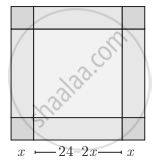Advertisements
Advertisements
प्रश्न
Answer the following:
Let f : R → R be given by f(x) = x + 5 for all x ∈ R. Draw its graph
उत्तर
f(x) = x + 5
| x | 1 | 0 | –5 | –6 |
| y = x + 5 | 6 | 5 | 0 | –1 |

APPEARS IN
संबंधित प्रश्न
Which of the following relations are functions? Give reasons. If it is a function, determine its domain and range.
- {(2, 1), (5, 1), (8, 1), (11, 1), (14, 1), (17, 1)}
- {(2, 1), (4, 2), (6, 3), (8, 4), (10, 5), (12, 6), (14, 7)}
- {(1, 3), (1, 5), (2, 5)}
Let f : R+ → R, where R+ is the set of all positive real numbers, such that f(x) = loge x. Determine
(c) whether f(xy) = f(x) : f(y) holds
If f(x) = (a − xn)1/n, a > 0 and n ∈ N, then prove that f(f(x)) = x for all x.
If f(x) = loge (1 − x) and g(x) = [x], then determine function:
(iv) \[\frac{g}{f}\] Also, find (f + g) (−1), (fg) (0),
Write the range of the function f(x) = ex−[x], x ∈ R.
If f(x) = cos (log x), then the value of f(x2) f(y2) −
If x ≠ 1 and \[f\left( x \right) = \frac{x + 1}{x - 1}\] is a real function, then f(f(f(2))) is
If f : R → R be given by for all \[f\left( x \right) = \frac{4^x}{4^x + 2}\] x ∈ R, then
Which of the following relations are functions? If it is a function determine its domain and range:
{(0, 0), (1, 1), (1, −1), (4, 2), (4, −2), (9, 3), (9, −3), (16, 4), (16, −4)}
Which sets of ordered pairs represent functions from A = {1, 2, 3, 4} to B = {−1, 0, 1, 2, 3}? Justify.
{(1, 3), (4, 1), (2, 2)}
Which sets of ordered pairs represent functions from A = {1, 2, 3, 4} to B = {−1, 0, 1, 2, 3}? Justify.
{(1, 1), (2, 1), (3, 1), (4, 1)}
Check if the relation given by the equation represents y as function of x:
x + y2 = 9
Find the domain and range of the following function.
f(x) = 7x2 + 4x − 1
Find the domain and range of the following function.
f(x) = `sqrt((x - 2)(5 - x)`
Check the injectivity and surjectivity of the following function.
f : Z → Z given by f(x) = x2
Check the injectivity and surjectivity of the following function.
f : N → N given by f(x) = x3
Express the following exponential equation in logarithmic form
54° = 1
Express the following logarithmic equation in exponential form
`log_(1/2) (8)` = – 3
Write the following expression as sum or difference of logarithm
In `(("a"^3 ("a" - 2)^2)/sqrt("b"^2 + 5))`
Write the following expression as a single logarithm.
`1/3 log (x - 1) + 1/2 log (x)`
Solve for x.
x + log10 (1 + 2x) = x log10 5 + log10 6
Select the correct answer from given alternatives.
If f(x) =`1/(1 - x)`, then f{f[f(x)]} is
Answer the following:
Show that, logy x3 . logz y4 . logx z5 = 60
Answer the following:
Find the domain of the following function.
f(x) = `(x^2 + 4x + 4)/(x^2 + x - 6)`
Answer the following:
Find the range of the following function.
f(x) = |x – 5|
Given the function f: x → x2 – 5x + 6, evaluate f(2a)
An open box is to be made from a square piece of material, 24 cm on a side, by cutting equal square from the corner and turning up the side as shown. Express the volume V of the box as a function of x

The domain of the function f(x) = `sqrtx` is ______.
Mapping f: R → R which is defined as f(x) = sin x, x ∈ R will be ______
Domain of function f(x) = cos–1 6x is ______.
Find the domain for which the functions f(x) = 2x2 – 1 and g(x) = 1 – 3x are equal.
The domain of the function f defined by f(x) = `1/sqrt(x - |x|)` is ______.
If f(x) = `x^3 - 1/x^3`, then `f(x) + f(1/x)` is equal to ______.
The domain of the function f defined by f(x) = `sqrt(4 - x) + 1/sqrt(x^2 - 1)` is equal to ______.
The domain and range of real function f defined by f(x) = `sqrt(x - 1)` is given by ______.
The domain of the function f given by f(x) = `(x^2 + 2x + 1)/(x^2 - x - 6)` is ______.
The expression \[\begin{array}{cc}\log_p\log_p\sqrt[p]{\sqrt[p]{\sqrt[p]{\text{...........}\sqrt[p]{p}}}}\\
\phantom{...........}\ce{\underset{n radical signs}{\underline{\uparrow\phantom{........}\uparrow}}}
\end{array}\]where p ≥ 2, p ∈ N; ∈ N when simplified is ______.
